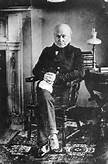The Contentious Election of 1824
John Quincy Adams was elected president without winning either the electoral or popular vote. The resentment caused by this disputed victory led to the birth of the Democratic Party.

6th U.S. President John Quincy Adams
The 1824 contest pitted four candidates against each other: Adams of Massachusetts, Henry Clay of Kentucky, William Crawford of Georgia, and Andrew Jackson of Tennessee.
Adams was secretary of state under President James Monroe. He had been favored to win primarily because those serving as secretary of state usually succeeded the outgoing president. As the son of former President John Adams, John Quincy had a famous family name and extensive foreign policy experience. But his anti-slavery views made him unpopular in the South, and his perceived elitist demeanor made him unpopular in the North.
Speaker of the House Henry Clay was known for his efforts to secure the Missouri Compromise between North and South in 1820. Clay was an influential politician who championed the “American System,” a program advocating more government intervention in the economy. He also claimed to oppose slavery, even though he owned slaves.
William Crawford was a prominent southern politician who was endorsed by Presidents Thomas Jefferson, James Madison and James Monroe. But since he was a strong supporter of slavery, he alienated northern voters. In addition, Crawford had suffered a stroke during the presidential campaign and was nearly paralyzed, which hurt his chances for victory.
Former General Andrew Jackson was a slavery advocate from Tennessee, and his status as a war hero of the War of 1812 and the Seminole War appealed to both northerners and southerners. Jackson was also viewed as a “man of the people,” and a man who could continue the legacy begun by George Washington in which top military leaders become president. He avoided committing to key issues and ignored the slavery issue during the campaign.
Each candidate was popular in a different region. Adams and Clay were strongest in the Northeast and Northwest respectively, and Crawford and Jackson were most popular in the Southeast and Southwest. From a political perspective, Adams and Clay were more similar in ideology than Crawford and Jackson. In addition, Clay personally detested Jackson because he felt that Jackson’s credentials as a military commander did not merit him becoming the president.
Character trumped issues in this campaign. Adams was ridiculed for his cold manner, Clay was accused of being a drunk, Crawford was accused of misconduct, and Jackson was accused of murder for ordering the execution of alleged Indian sympathizers during the Seminole War. Many states allowed men who owned no property to vote for the first time, which held the potential for a large voter turnout.
When the results were tallied, Jackson received 99 electoral votes, more than any other candidate. He also won more popular votes than Adams and Clay combined. Adams finished second with 84, Crawford finished third with 41, and Clay finished fourth with 37. Even though Jackson finished first, he fell short of the 51 percent of the electoral votes needed for victory, so he could not be declared the winner. Instead, the House of Representatives was required to decide the contest.
Under the Twelfth Amendment, only the top three vote-getters could be considered, so Clay was eliminated. But as House speaker, Clay had enormous influence over who would win the election. Crawford’s stroke and his polarizing support of slavery left him out, leaving Jackson and Adams. Since Clay despised Jackson, and since Clay was more politically similar to Adams, the House elected Adams president on the first ballot. Clay cast the final ballot to award the election to Adams.
Jackson’s supporters were shocked and dismayed by Adams’s quick victory. They protested that the will of the people had been ignored. However, this was not entirely true because only four states had all four candidates on the ballot. Also, none of the candidates could truly represent the true will of the people because women and blacks–a large portion of the people–were barred from voting.
The Jacksonian protests turned into outrage when Adams named Clay to be his secretary of state. Since secretaries of state had traditionally succeeded outgoing presidents, this meant that Clay could have been next in line for the presidency. Consequently, many Jackson backers accused Adams and Clay of making a “corrupt bargain” to rob Jackson of the White House.
Both Adams and Clay denied the charges, and no evidence suggests that a deal had been struck before Adams was elected. But the fact that Adams won the presidency without winning either the popular or electoral vote, and the fact that Clay was appointed to Adams’s top cabinet post left many bitter and eager for revenge four years later.
Adams had enjoyed only moderate popularity before becoming president, and his perceived alliance with Clay to defeat Jackson doomed him to an ineffective term. His presidency was constantly challenged by a coalition devoted to defeating him in the next election.
This began the modern two-party system in American politics, as Adams’s supporters became known as the National Republicans, and Jackson’s supporters formed the Democratic Party, one of the first national political parties in the U.S. The Democrats finally elected Jackson president four years later.





